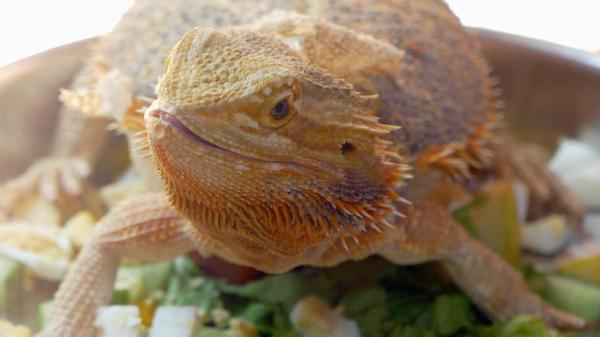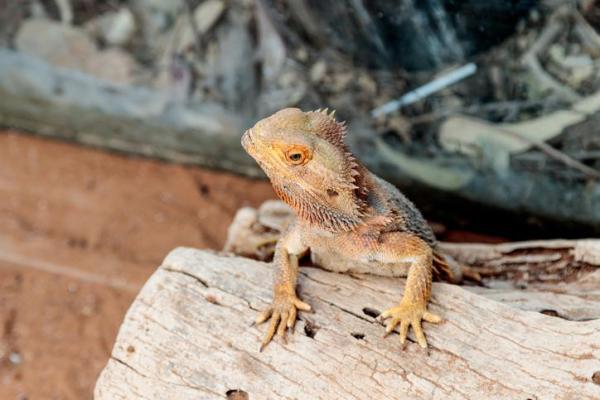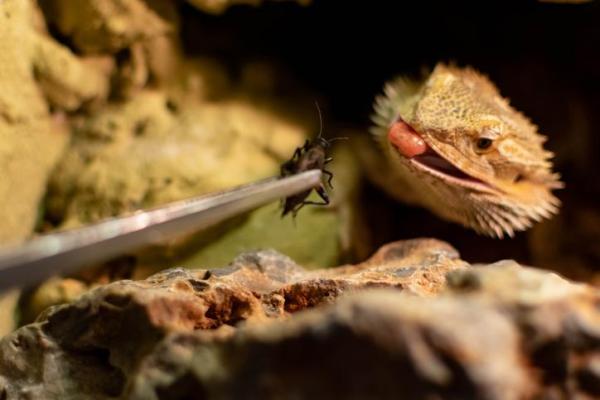
The bearded dragon (Pogona vitticeps) is a type of lizard that has gained popularity as a pet in recent years. Nowadays, bearded dragons are among the most well-known species in the pogona genus. Their small size, docile nature, and high sociability make them great pets for beginners. Taking good care of a bearded dragon is a lot easier than caring for other larger, more territorial lizards, such as iguanas.
If you are thinking of adopting a lizard as a pet, keep reading this AnimalWised article, where we teach you how to take proper care of the bearded dragon.
Prepare the terrarium
The first thing you will need to do before bringing home your new pet is to prepare the terrarium. Keep in mind your bearded lizard will spend most of its time here. For this reason, the terrarium has to have all the appropriate conditions in order to ensure the correct physical and cognitive development of your new pet.
In order to choose the right tank for your terrarium, you need to make sure it has the proper dimensions. Adult bearded dragons can grow up to 23" long and weigh between 14 and 15 oz. Males are slightly larger than females and have protrusions on both sides of their tails. Despite their small size, bearded dragons are quite active, move quickly, and love to climb. Therefore, an individual tank should be at least 48 x 13 x 21". If, on the other hand, you are thinking of having a pair of pogonas, then the tank should be 48 x 19 x 22". It is very important that the terrarium has its own lid to prevent the lizards from escaping.
After choosing the right terrarium for your bearded dragon, you must fill it with elements that recreate their natural habitat. This is a great way of stimulating your pet both physically and mentally. In addition to a feeding and drinking trough, you can also add branches, artificial plants, or stones.
The decoration of your bearded dragon's terrarium is up to you, but make sure each pogona has enough space to move around and explore. Also, place a cave or small shelter inside the tank to ensure that your pogona has a place to hide and rest. Finally, we advise you to spread a good substrate of sand or dry soil at the bottom of the tank before placing the branches, plants, and other accessories.

Create the proper habitat
Bearded dragons are native to the deserts and dry forests of Australia. These lizards feel comfortable on the ground or in the sand where they can get the heat they need to survive. Bearded dragons are accustomed to dealing with the desert's wide range of temperatures, which can reach 98-102°F during the day and then descend to 28-26°F during the night. This means they can experience an extreme of both heat and cold during a 24 hour period.
First of all, you need to consider the area where you are going to place the terrarium, the amount of light it will receive, and the average temperature. Ideally, the temperature should be between 77°F and 95°F.
It is very important the terrarium has a warm and bright area and a cool and dark one. To do this, you will need to use a lamp that provides UVA and UVB light. Place it in one of the corners of your lizard's terrarium. Artificial lighting is essential, not only because they help to keep the environment warm, but also to provide the right amount of radiation.
Bearded dragons need radiation to synthesize vitamin D, absorb calcium, and maintain their general good health. Normally, it is recommended to leave the lamp on for 10-12 hours during the day. During the nights, it is very important to turn the lamp off to allow the temperature to drop and the lizard to rest.
If you live in a place where the winters are cold, you should also pay special attention to the ambient temperature of your home. Don't let it drop below 77°F. A good heating system can help them survive the long winter months but it can also alter the humidity levels of your terrarium. Low humidity can cause respiratory or skin problems in your bearded dragon. Yet, this problem can be easily fixed by spraying clean water at least twice a day inside the tank.
Provide a balanced diet
Bearded dragons are omnivorous and enjoy a varied diet that incorporates animal protein, fruits, and vegetables.
In specialized pet stores, it is possible to find processed food for bearded dragons. The great advantage of this kind of food, in addition to its practicality, is that these products have been specifically formulated to have all the essential nutrients your pet needs. Nonetheless, it is not advisable to limit the diet of your bearded dragon to this type of industrialized product only. We recommend supplementing their diet with fresh and healthy food.
Although these lizards love vegetables, basing their diet on the consumption of plants matter alone is a serious mistake that can lead to nutritional deficits and consequent health problems. Bearded dragons need to ingest animal protein in order to properly develop their muscle mass and maintain a stable metabolism.
The best sources of protein for a bearded dragon are:
- Crickets
- Flies
- Worms
- Honey worms
- Snails
- Lobsters
The best vegetable products and cereals for a bearded dragon are:
- Apricot
- Alfalfa
- Celery
- Cooked rice
- Chard
- Watercress
- Sweet potato
- Broccoli
- Borage
- Dandelion
- Green beans
- Lentils
- Soy
- Zucchini
- Pumpkin
- Thistle
- Cabbage
- Brussels sprouts
- Endive
- Asparagus
- Green peas
- Kiwi
- Blackberries
- Raspberries
- Figs
- Tangerine
- Mango
- Corn
- Apple
- Cantaloupe
- Mulberry leaves
- Papaya
- Cucumber
- Pepper
- Plantain
- Leek
- Radish
- Beetroot
- Cabbage
- Arugula
- Tomato
- Grapes
- Carrot
To provide the best diet for your bearded dragon, it is essential to consult a veterinarian who specializes in this type of reptile. The professional will also be able to evaluate the need and benefits of administering certain supplements and vitamins in your lizard's diet in order to offer the most appropriate care.

Take good care of their health
When provided with a positive environment and proper care, bearded dragons rarely get sick. Their life expectancy can be as much as 15 years in captivity. The most common health problems in these lizards are infestations of ectoparasites (mainly ticks and mites), oral diseases, and salmonella.
In general, the main cause of disease in the bearded dragon is poor hygiene in its terrarium. The accumulation of food waste and excrement favors the proliferation of bacteria, fungi, parasites, and different pathogens. A part of their essential health care is to regularly clean its stools and food remains, change its water daily and perform a complete sanitization of the entire terrarium at least 2 times a month. You can use warm water and mild soap to wash the terrarium, avoiding corrosive chemicals.
Nutritional deficiencies can also lead to numerous health problems. An unbalanced diet weakens their immune system, leaving them exposed to various diseases. The consumption of the wrong food and toxic plants can cause them to have serious digestive disorders and poisoning. We reinforce the need to offer complete and balanced nutrition in order to guarantee the best care for your bearded dragon.
If you notice that your dragon's skin has changed its color or texture, or if you observe that it is dry or has cracks, consult a specialized veterinarian. Most of the time, these changes in the skin are signs of calcium or vitamin deficiency.
It is essential to remember that the bearded dragon is sociable and needs to develop its cognitive and emotional abilities. In addition to enriching their terrarium, you will need to interact with your pogona on a daily basis. Experienced keepers always recommend adopting pairs of bearded dragons, as they tend to live better when accompanied.
Finally, we highlight that reptiles can develop digestive, respiratory, and ophthalmological problems asymptomatically, i.e. without showing visible signs of disease. Therefore, the health care of a bearded dragon should also include preventive visits to the veterinarian every 6 months.
Not all reptiles will make as good a pet as the bearded dragon. Take a look at our article on whether pythons make good pets to learn more.
If you want to read similar articles to Taking Care of Pet Bearded Dragon, we recommend you visit our Basic care category.